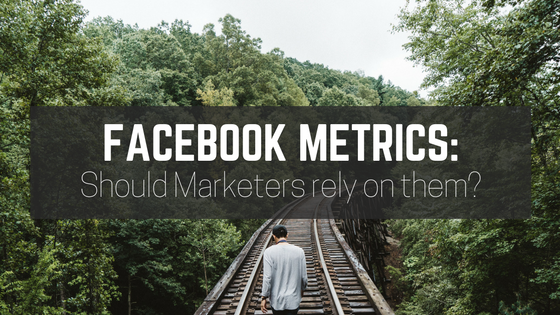
It’s not unlike Facebook to update the way they report insights to marketers. As the variety of content capabilities grow, the ability to accurately convey Facebook metrics becomes increasingly complicated. Couple that with periodical algorithmic changes and the challenge becomes even bigger.
Instances of widespread errors in their reporting are now not uncommon – so just how much weight should marketers put on Facebook metrics?
The short answer is a lot. As the world’s leading social networking site that commands a significant chunk of the marketing budget of most of the world’s biggest brands, Facebook has a duty to get it right in order to justify the pricing of their services. The trouble is, there can often be discrepancies between what should be regarded as high-enough engagement levels to be considered a reputable return on investment. Especially on a site where regular activity varies so immensely from user to user.
Take the recent miscalculations to Facebook video views for example. Back in September the social network admitted to considering a video as “viewed” when a user had only watched 3 seconds of it. Understandably, while Facebook confirmed that they were not overcharged during the time the issue was active, many advertisers still took issue with this kind of reporting as they considered it misleading.
Facebook focus on enhancing and updating reporting
The video metrics blunder was a mistake that required immediate rectification. What we can take from it that is refreshing is Facebook’s approach. They are willing to be open to mistakes and communicate how they are constantly updating the way they provide metrics to marketers. It seems they are comfortable to take a stance on metrics that reflects their emphasis on development of features for users – of which there has been a great deal in past months – the subject of another article entirely.
The latest batch of updates focused on a number of different areas including Organic Reach, Apps and Video reporting. It’s important to note that Facebook have made it clear that they “do not bill clients on the potential under-reporting/over-reporting metric issues” that have been uncovered.
Alongside the announcement of these updates, Facebook made a pledge to provide regular and clear communication on their metrics, stating that they were developing more measurement solutions with their clients and expanding third-party verification of their reported data to even more partners. This will include Nielsen for video and Facebook Live.
Let’s look at each of the latest updates in-depth:
Organic reach metric updates
Facebook flagged a bug in Pages dashboards that caused one reach summary number to be miscalculated as “a simple sum of daily reach instead of de-duplicating repeat visitors over those periods”. This was a small bug that didn’t affect the vast majority of other organic reach data. What is interesting however is that Facebook have pledged to make reporting of organic reach on Facebook metrics closer to that of paid content.
This change will make it likely that marketers’ organic reach will be on average 20% lower. This can be expected in the coming months. While numbers will be lower, they will nevertheless hold far more weight and provide more reliable foundations for those looking to build organic growth through original content marketing.
“On Pages, we’ve historically defined reach as a person refreshing their News Feed and the post being placed in their feed. For paid ads reports, we’ve moved to a stricter definition that only counts reach once the post enters the person’s screen (“viewable impressions”).”
Measuring video completions
Measuring video completions has been a tricky obstacle for Facebook, owing to the fact that the length of a video can differ by a fraction on different devices when the audio and video tracks don’t line up. Having an accurate understanding of video completions is very important, especially at a time when social media video marketing is held in such high regard. Facebook are updating how they analyse video completions as a result:
“Moat found and reported it [this issue] to us. We are now updating how we read the video length to address this issue. This may result in roughly a 35% increase in the count of “video watches at 100%.””
Measuring time spent on Instant Articles
The social network have stated that time spent on Instant Articles has been over-reported on Facebook metrics at an average of 7-8% since August last year. If you are unfamiliar with them, Instant Articles are a tool for publishers that uses the same technology used to display photos and videos quickly within the app in order to give users a faster and more responsive reading experience, reducing the likelihood of them abandoning the article after clicking.
“This [miscalculation of time spent] was caused by a calculation error: we were calculating the average across a histogram of time spent, instead of reflecting the total time spent reading an article divided by its total views. We have now fixed this issue.”
Measuring app referrals
Facebook also announced that Referrals within Facebook Analytics for Apps dashboard had been miscalculated, taking into account clicks that didn’t go directly to an app or website. This will likely come as significant annoyance to users whose primary strategy focuses on app promotion; in order to best understand the value of each hit, they will want to weigh up referrals next to downloads.
“Out of the [app] referrals we currently report, on average about 30% are actually clicks to consume content on Facebook. For power users of this metric (top apps that look at this data in the dashboard most frequently), we found that referrals have been overstated by approximately 6% on average. Other measurements of referrals, such as those appearing in Facebook’s ads reporting tools, are unaffected.”
Follower counts affected as Interest Lists dropped
Remember Interest Lists? Introduced back in 2012, they allowed users to follow and organise particular types of content so that they had more control over their News Feed. The feature never took off and as a result Facebook have decided to retire it. Although not a feature within Facebook metrics, this nevertheless may result in certain users seeing a drop in follower counts depending on whether or not they engaged with or were featured in lists.
“The impact to profile follower counts will vary, depending on the number of interest lists the profile created and was featured in. Most profiles will see a drop in followers of less than 5%.”
Clarifications to metrics
At the end of the post, Facebook announced updates to the process of reporting that will help clarify details and make reports easier to understand. These will include more descriptive names, such as the re-labelling of “video views” to “3-second video views”, clarifications to calculations of certain metrics, regulated definitions that are more consistent across-board, and better categorisation for marketers to customise their reports. These can all be explored in full detail on this post on Facebook’s business centre.
Placing weight on metrics
In conclusion, so long as Facebook continue in their willingness to hold themselves accountable for the information they report, marketers should have little concern about placing weight on metrics. In the grand scheme, social media has grown at such an exponential rate that tools such as these have had to catch up.
There will always be certain issues and aspects of Facebook metrics that are hazy. The trick is to stay alert and aware of updates so that you don’t get caught out or taken aback by sudden changes to your reports.
Check out the Infographic below…
![[Infographic] Facebook Metrics Updates](https://giraffesocial.wpengine.com/wp-content/uploads/2016/11/Facebook-Metrics-Update-Infographic-e1480418088934.png)




